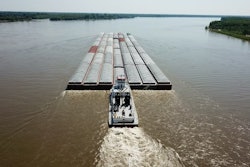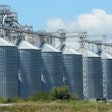
Similar to 2022, the Mississippi River is again offering low-water levels from hot, dry weather. The USDA Grain Transportation Report noted barges are unable to ship their normal loads just as harvested corn and soybeans are getting ready to travel down river, raising transportation costs for farmers who have faced a challenging summer fraught with drought.
American Commercial Barge Line reported that as of September 18, between Cairo, Illinois, and the U.S. Gulf, loading drafts for barges are down 24% from normal, and tow sizes are down 17% to 38% from normal. These changes have resulted in transit delays of two to three days.
Loading drafts on the Illinois River and Mid-Mississippi River (including, at St. Louis, Missouri) have been reduced by 15%, and tow size has been reduced between St. Louis, Missouri, and Cairo, Illinois.
- After dipping to $8.06 per ton for the week of June 6, the spot rate at St. Louis rose 376 percent, to $38.34, this week, slightly higher than the rate of $38.10 this time last year
The U.S. Army Corps of Engineers continues to dredge various portions of the Mississippi River system. Forecasted precipitation should help stabilize current water levels, however, further restrictions are possible if water levels continue to fall.
Cargo rates surge
According to reports, about 60% of U.S. grain exports are taken by barge down the Mississippi to New Orleans, where the grain is stored and ultimately transferred to other ships. It’s usually an inexpensive, efficient way to transport crops, as a typical group of 15 barges lashed together carries as much cargo as about 1,000 trucks.
But as river levels drop, that cost has surged. The cargo rate from St. Louis southward is now up 77% above the three-year average.
Mike Steenhoek, executive director of the Soy Transportation Coalition, told We Are Iowa that many Midwest farmers have multiple transport options, among them trucking and shipment by train for use by nearby ethanol and biodiesel plants and for processing into animal feed. But for grain exported from the U.S., the higher cost of shipping down the Mississippi hurts.
Rising barge costs eating directly into farmers' profits come at a time when American soybean and corn exports face increased international competition, he said.


















